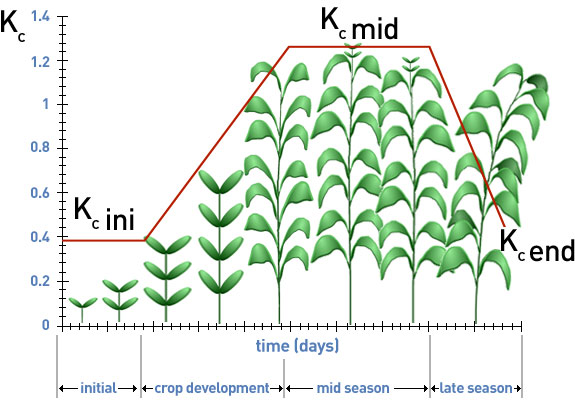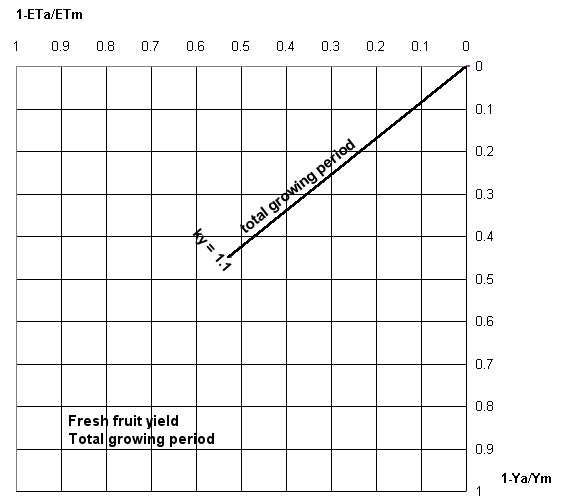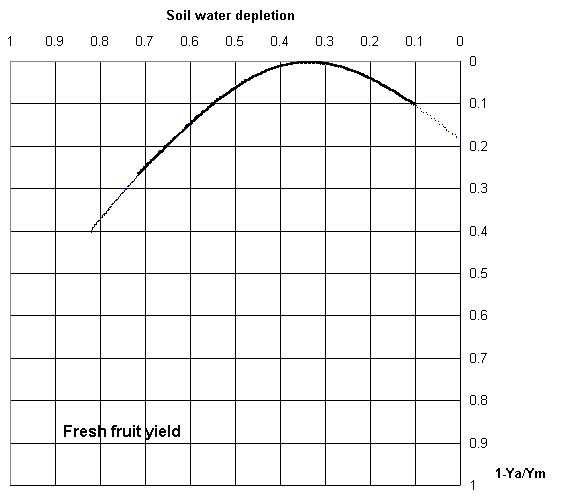Pepper
This section presents information on water relations and water management of pepper and provides links to other sources of information.
Crop Description and Climate
Crop Description and Climate
Pepper (Capsicum annum and Capsicum frutescens) is thought to originate from tropical America. Most of the peppers grown belong to C. annum but the small, pungent peppers belong to C. frutescens. Present world production is about 19 million tons fresh fruit from 1.5 million ha.(FAOSTAT, 2001).
Pepper thrives in climates with growing season temperatures in the range of 18 to 27°C during the day and 15 to 18° C during the night. Lower night temperatures result in greater branching and more flowers; warmer night temperatures induce earlier flowering and this effect is more pronounced as light intensity increases.
The crop is grown extensively under rainfed conditions and high yields are obtained with rainfall of 600 to 1250 mm, well-distributed over the growing season. Heavy rainfall during the flowering period causes flower shedding and poor fruit setting, and during the ripening period rotting of fruits.
Light-textured soils with adequate water holding capacity and drainage are preferred. Optimum pH is 5.5 to 7.0 and acid soils require liming. Waterlogging, even for short periods, causes leaf shedding. Fertilizer requirements are 100 to 170 kg/ha N, 25 to 50 kg/ha P and 550 to 100 kg/ha K.
The crop is moderately sensitive to soil salinity, except in the seedling stage when it is more sensitive. Yield decrease at different levels of ECe is: 0% at ECe 1.5 mmhos/cm, 10% at 2.2, 25% at 3.3, 50% at 5.1 and 100% at ECe 8.5 mmhos/cm.
Seeds are sown in nursery beds which in the cooler climates are sometimes enclosed and heated since soil temperatures in the range of 20 to 24°C are considered optimum for germination. Seedlings of 10 to 20 cm height are transplanted in the field after 25 to 35 days. The length of the total growing period varies with climate and variety but in general it takes 120 to 150 days from sowing to the latest harvest. Prior to transplanting, the seedlings raised in enclosed and heated nurseries are hardened by increased ventilation. The plants are sometimes topped 10 days before transplanting to encourage branching. Plant spacing is 0.4 to 0.6 m x 0.9 m. For production of fruits for canning, closer spacings are sometimes used. Flowering starts 1 to 2 months after transplanting with first picking of green peppers 1 month later. Thereafter, ripe, red peppers are picked at 1 to 2 week intervals for up to 3 months. Ripe chillies are semi-dried for 3 to 15 days, with the final weight being about 25 percent of the fresh fruit weight.
The graph below depicts the crop stages of pepper, and the table summarises the main crop coefficients used for water management.

Stages of | Plant | Region | |||||
|---|---|---|---|---|---|---|---|
Crop | Initial | Crop | Mid-season | Late | Total |
| |
Stage length, | 25/30 | 35 | 40 | 20 | 125 | Apr/Jun | Europe and Medit. |
Depletion Coefficient, p: | 0.2 | >> | 0.3 | 0.5 | 0.3 | ||
Root Depth, m | 0.25 | >> | - | 0.8 | - | ||
Crop Coefficient,Kc | 0.6 | >> | 1.05 | 0.9 | - |
| |
Yield Response Factor, Ky | - | - | - | - | 1.1 |
|
|
Water Requirements
Water Requirements
Total water requirements (ETm) are 600 to 900 mm and up to 1250 mm for long growing periods and several pickings. The crop coefficient (kc) relating reference evapotranspiration (ETo) to maximum evapotranspiration (ETm) is 0.4 following transplanting, 0.95 to 1. 1 during full cover and for fresh peppers 0.8 to 0.9 at time of harvest.
Water Supply And Crop Yield
Water Supply And Crop Yield
The relationships between relative yield decrease (1 - Ya/Ym) and relative evapotranspiration deficit for the total growing period of root yield are shown in the figure below.
The relationships between relative yield decrease (1 - Ya/Ym) and soil water depletion for pepper are shown in the figure below.

For high yields, an adequate water supply and relatively moist soils are required during the total growing period. Reduction in water supply during the growing period in general has an adverse effect on yield and the greatest reduction in yield occurs when there is a continuous water shortage until the time of first picking. The period at the beginning of the flowering period is most sensitive to water shortage and soil water depletion in the root zone during this period should not exceed 25 per-cent. Water shortage just prior and during early flowering reduces the number of fruits. The effect of water deficit on yield during this period is greater under conditions of high temperature and low humidity. Controlled irrigation is essential for high yields because the crop is sensitive to both over and under irrigation.
With poor quality (saline) water the yield of first pickings is reduced but the effect is less pronounced on later pickings. Sprinkling with poor quality (saline) water causes leaf burn and 'nose rot' of the fruits. Water deficits during yield formation period lead to shrivelled and malformed fruits. The pungent quality of the fruit (hotness) can to a certain degree be influenced by water supply.
Under conditions of limited water supply, total production is increased by meeting full crop water requirements over a limited area, rather than by extending the area and partially meeting the crop water requirements.
Water Uptake
Water Uptake
Pepper has a tap root which is broken at the time of transplanting and a profusely branched lateral root system subsequently develops. Root depth can extend up to 1 m but under irrigation roots are concentrated mainly in the upper 0.3m soil depth. Normally 100 percent of the water uptake occurs in the first 0.5 to 1.0 m soil depth (D = 0.5-1.0 m). Under conditions when maximum evapotranspiration is 5 to 6 mm/day, 25 to 30 percent of the total available soil water can be depleted until soil water uptake wi 11 be reduced (p=0.25 to 0.30).
Irrigation Scheduling
Irrigation Scheduling
For optimum yield levels the soil water depletion in most climates should not exceed 30 to 40 percent of the total available soil water. Due to the low depletion level light irrigation applications are required. Irrigation frequencies of 4 to 7 days are common. When water supply is short, irrigation should preferably be adequate up to the first picking and savings may be made thereafter.
Irrigation Methods
Irrigation Methods
Peppers are grown under surface, sprinkler and drip irrigation. With sprinkler irrigation, yields tend to be higher under light applications as compared to heavy intensity sprinkling. However, with poor quality water, heavy intensity and large amounts are generally preferred with sprinkler irrigation because of reduced leaf burning and improved leaching of salts. The crop is particularly suitable for drip irrigation where very high yields can be obtained.
Yield
Yield
Yields vary greatly with climate and length of growing period, e.g. number of pickings. Under irrigation commercial yields are in the range of 10 to 15 ton/ha fresh fruit and 20 to 25 ton/ha are obtained under favourable climatic conditions. However, the marketable yield percentage may vary. Number of pickings is 1 for machine harvesting and up to 6 for hand picking, depending on the length of the harvesting period. The water utilization efficiency for harvested yield (Ey) for fresh pepper containing about 90 percent moisture varies between 1.5 and 3.0 kg/m3
